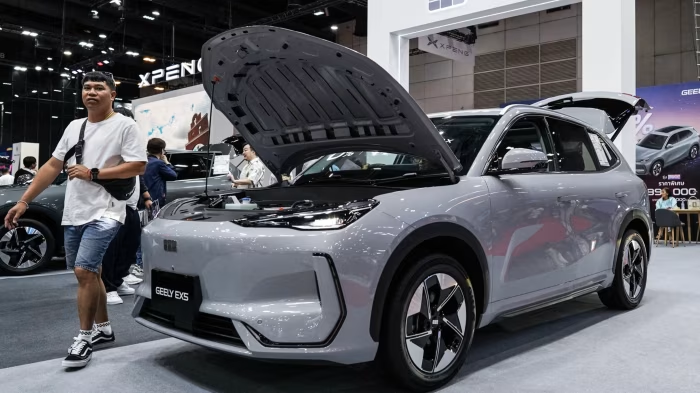In a recent New York Times interview, Sir Anthony Hopkins spoke of a night that divided his life into before and after. It was December 29, 1975, 11 p.m., in Los Angeles. “I was in big, big trouble because I couldn’t remember anything and I…
Blog
-

Ride onboard with Lando Norris for his stunning pole lap in Mexico City Grand Prix Qualifying
Lando Norris will start from pole position at the Mexico City Grand Prix after topping Qualifying for the fifth time this season on Saturday.
Norris’ 1m 15.586s effort put him 0.262s clear of fellow front row starter Charles Leclerc in…
Continue Reading
-

High-risk groups better protected against shingles
The China National Medical Products Administration (NMPA) has approved Shingrix (GSK”s Recombinant Zoster Vaccine or RZV) for the prevention of shingles (herpes zoster) in adults aged 18 years and…
Continue Reading
-

How Investors Are Reacting To NXP Semiconductors (NXPI) Expanding Software Focus Through eInfochips Alliance
-
eInfochips and NXP Semiconductors recently announced a multi-year collaboration to provide software distribution, tools, and support services for NXP’s S32 family of microcontrollers and microprocessors.
-
This partnership emphasizes NXP’s growing focus on enabling faster customer application development and strengthening its role in software-driven automotive and industrial platforms.
-
We’ll examine how NXP’s commitment to software solutions through this alliance may reshape the company’s growth outlook and investment narrative.
Outshine the giants: these 27 early-stage AI stocks could fund your retirement.
To own shares in NXP Semiconductors, it helps to believe in a sustained rebound in global automotive and industrial semiconductor demand, as well as NXP’s ability to leverage advanced software solutions in these sectors. The recently announced collaboration with eInfochips to accelerate software distribution for S32 platforms is a meaningful nod to this vision, though it is not expected to materially shift the primary near-term catalyst, which remains the normalization of automotive Tier 1 inventory levels. The key risk, weak end-demand recovery and modest revenue performance, remains unchanged and central for shareholders to monitor.
Of the recent announcements, the multi-year partnership with eInfochips stands out for its alignment with the company’s ambition to drive software-enabled innovation in automotive and industrial solutions. While this announcement reinforces NXP’s positioning in software-driven automotive platforms, the bigger immediate catalyst continues to be improved order visibility as inventory headwinds ease across core automotive customers, a development closely awaited by investors.
Yet, with persistent concerns over customer inventory normalization possibly stalling if macro conditions weaken, it’s essential that investors understand the risk posed by…
Read the full narrative on NXP Semiconductors (it’s free!)
NXP Semiconductors’ narrative projects $15.5 billion revenue and $3.5 billion earnings by 2028. This requires 8.7% yearly revenue growth and a $1.4 billion earnings increase from $2.1 billion today.
Uncover how NXP Semiconductors’ forecasts yield a $258.19 fair value, a 18% upside to its current price.
NXPI Community Fair Values as at Oct 2025 Ten fair value estimates from the Simply Wall St Community range from US$187.08 to US$294.09 per share, showcasing wide disagreement on future possibilities. With inventory recovery as a decisive catalyst, it’s worth considering how quickly opinions can shift among market participants, explore these differing perspectives to inform your view.
Continue Reading
-
-
Tinier than a Grain of Sand: Physicists Create the World’s Smallest Light Pixel – SciTechDaily
- Tinier than a Grain of Sand: Physicists Create the World’s Smallest Light Pixel SciTechDaily
- Scientists develop retina E-paper display with 25k pixels per inch, matching human vision The Brighter Side of News
- Colour e-paper screen offers…
Continue Reading
-

Ek Deewane Ki Deewaniyat worldwide box office collection: Harshvardhan Rane film earns ₹44 cr, beats Dhadak 2 lifetime
₹44 cr, beats Dhadak 2 lifetime”>Published on: Oct 26, 2025 10:35 am IST
Ek Deewane Ki Deewaniyat’s worldwide box office collection is inching towards the ₹50 crore mark, eclipsing the lifetime haul of Karan Johar’s Dhadak 2.
Continue Reading
-

AI generates surge in expense fraud
Stay informed with free updates
Simply sign up to the Artificial intelligence myFT Digest — delivered directly to your inbox.
Businesses are increasingly being deceived by employees using artificial intelligence for an age-old scam: faking expense receipts.
The launch of new image-generation models by top AI groups such as OpenAI and Google in recent months has sparked an influx of AI-generated receipts submitted internally within companies, according to leading expense software platforms.
Software provider AppZen said fake AI receipts accounted for about 14 per cent of fraudulent documents submitted in September, compared with none last year. Fintech group Ramp said its new software flagged more than $1mn in fraudulent invoices within 90 days.
About 30 per cent of US and UK financial professionals surveyed by expense management platform Medius reported they had seen a rise in falsified receipts following the launch of OpenAI’s GPT-4o last year.
An AI-generated receipt © AppZen “These receipts have become so good, we tell our customers, ‘do not trust your eyes’,” said Chris Juneau, senior vice-president and head of product marketing for SAP Concur, one of the world’s leading expense platforms, which processes more than 80mn compliance checks monthly using AI.
Several platforms attributed a significant jump in the number of AI-generated receipts after OpenAI launched GPT-4o’s improved image generation model in March.
OpenAI told the Financial Times that it takes action when its policies are violated and its images contained metadata that signalled they were created by ChatGPT.
Creating fraudulent documents previously required skills in photo editing or paying for such services through online vendors. The advent of free and accessible image generation software has made it easy for employees to quickly falsify receipts in seconds by writing simple text instructions to chatbots.
Several receipts shown to the FT by expense management platforms demonstrated the realistic nature of the images, which included wrinkles in paper, detailed itemisation that matched real-life menus, and signatures.
“This isn’t a future threat; it’s already happening. While currently only a small percentage of non-compliant receipts are AI-generated, this is only going to grow,” said Sebastien Marchon, chief executive of Rydoo, an expense management platform.
The rise in these more realistic copies has led companies to turn to AI to help detect fake receipts, as most are too convincing to be found by human reviewers.
The software works by scanning receipts to check the metadata of the image to discover whether an AI platform created it. However, this can be easily removed by users taking a photo or a screenshot of the picture.
To combat this, it also considers other contextual information by examining details such as repetition in server names and times and broader information about the employee’s trip.
“The tech can look at everything with high details of focus and attention that humans, after a period of time, things fall through the cracks, they are human,” added Calvin Lee, senior director of product management at Ramp.
Research by SAP in July found that nearly 70 per cent of chief financial officers believed their employees were using AI to attempt to falsify travel expenses or receipts, with about 10 per cent adding they are certain it has happened in their company.
Mason Wilder, research director at the Association of Certified Fraud Examiners, said AI-generated fraudulent receipts were a “significant issue for organisations”.
He added: “There is zero barrier for entry for people to do this. You don’t need any kind of technological skills or aptitude like you maybe would have needed five years ago using Photoshop.”
Continue Reading
-

Women’s health could benefit from the private equity treatment
Unlock the Editor’s Digest for free
Roula Khalaf, Editor of the FT, selects her favourite stories in this weekly newsletter.
Private equity firms are rarely credited with helping to cure societal ills. But sometimes, as in the case of Blackstone and TPG’s $18bn purchase of medical technology group Hologic, buyout shops have a chance to do good and do well at the same time.
Hologic is focused on women’s health, providing devices for cervical and breast cancer screening, as well as uterine health. Women generally are an underserved market, tending to receive less effective treatments and poorer care than male patients. Eliminating the gap could be worth $1tn to the global economy by 2040, McKinsey and the World Economic Forum estimated last year, much of it through recovering the seven days the average woman loses per year to ill health.
Medicine has historically failed to take into account sex-based differences as fundamental as the workings of the heart or lung capacity. Standard asthma inhalers are far less effective for women than men, for example. Caroline Criado Perez’s 2019 bestseller Invisible Women notes that clinical trials don’t routinely document the sex of respondents nor necessarily aim for balance. Some drugs that might work for women risk getting dropped because they are less effective on the men who make up the majority of trial subjects.
As well as more effective treatment of conditions that afflict men and women, there are opportunities in alleviating female-specific conditions too. The potential market for endometriosis treatments is estimated at between $180bn-$220bn, McKinsey reckons, based on the number of women seeking help with the condition. The consultancy pegs the market for menopause treatments at between $120bn-$230bn.
While comparing the valuation of healthcare groups is not easy given their different products and specifications, Blackstone seems to be getting Hologic for a reasonable sum. The $18.3bn enterprise value — the full price if certain performance targets are met later — represents 14 times 2024 ebitda. That’s one-third below the average for large healthcare deals in the past five years, according to analysis of Dealogic data.
Private equity may not be known for its desire to heal the world, but it does have a well-earned reputation for spotting profitable niches and growing them smartly. Often that means “rolling up” acquisitions to create bigger groups able to invest and innovate more than smaller companies could alone. Hologic could lend itself to such treatment. Reducing sex-based medical inequities may not be the primary goal, but it could nonetheless be a happy side effect.
jennifer.hughes@ft.com
Continue Reading
-

Six autumn getaways for relaxing like a local
Unlock the Editor’s Digest for free
Roula Khalaf, Editor of the FT, selects her favourite stories in this weekly newsletter.
Total immersions in South America
A pool at Awasi Mendoza in Luján de Cuyo, Argentina Awasi Mendoza, Argentina; Awasi…
Continue Reading
-

Geely targets 100,000 UK sales in push to take on Tesla and BYD
Stay informed with free updates
Simply sign up to the Automobiles myFT Digest — delivered directly to your inbox.
Chinese carmaker Geely wants to sell 100,000 cars a year in the UK and would consider local production as it aims to take on Tesla and BYD in Europe’s second-largest market for electric vehicles.
The UK has become a battleground for European expansion by Chinese carmakers because of strong EV sales and the absence of import tariffs.
“Currently the UK market is more open and a friend for Chinese brands,” Michael Yang, the head of Geely Auto UK, told the Financial Times.
Geely would aim to launch 10 electric and plug-in hybrid models over the next three years and sell about 100,000 cars a year in the UK, he said in an interview. This would give it a market share of around 5 per cent in the country. BYD and Tesla have a share of around 2 per cent each this year.
“In the future, if we find that local production has more of an advantage, why not do that? We are open about that,” he added, saying the company planned to hire about 300 workers in the UK.
Geely Auto is a Hong Kong-listed unit of privately held Geely Holding, one of the world’s biggest auto groups, with stakes in Volvo Cars, Polestar, Lotus, London black-cab maker LEVC and Aston Martin.
The first Geely car to be sold in the UK will be the all-electric EX5 sport utility vehicle, a rival to Tesla’s flagship Model Y, with a starting price of £31,990.
LEVC employees assemble a taxi at a factory in Coventry, England © Christopher Furlong/Getty Images The UK government has been courting Chinese carmakers to produce in the country. But it has had little success so far because of the high cost of energy and labour compared with other locations such as Turkey, Hungary and Spain, which have managed to attract Chinese groups to build European production hubs.
The UK is aiming to produce 1.3mn vehicles a year by 2035, almost double the 755,000 units the Society of Motor Manufacturers and Traders expects to be made this year.
Hitting the target will require new manufacturing. Chinese brands have become a focus as established groups grapple with various problems.
Nissan, which owns the largest UK plant, is downsizing its global operations because of financial difficulties. Jaguar Land Rover’s production had to be halted for more than a month following a cyber attack, which caused vehicle output in the UK to fall 36 per cent in September, according to the SMMT.
Meanwhile, the UK has become BYD’s biggest market outside China with sales increasing nearly 10-fold in a year, according to the latest data.
Chery, another Chinese carmaker, which sells the Chery, Omoda and Jaecoo brands, accounted for nearly 4 per cent of new car sales last month, compared with 0.4 per cent just a year earlier.
When asked whether Geely would consider using existing LEVC and Lotus manufacturing facilities for new UK production, Yang said: “It all depends, but hopefully we can use the existing plant. It’s easier.”
Lotus said earlier this year that it would pull out of manufacturing in the UK. This decision was later reversed but it has been talking with other carmakers about building models at its plant in Hethel in eastern England.
Yang also said that the various Geely brands would not cannibalise each other since they all target different customers.
“Volvo and Polestar, they are more like premium brands and Lotus is a performance car,” he said. “LEVC in the UK is for the iconic taxi, so Geely is focusing more on the mainstream.”
Continue Reading
